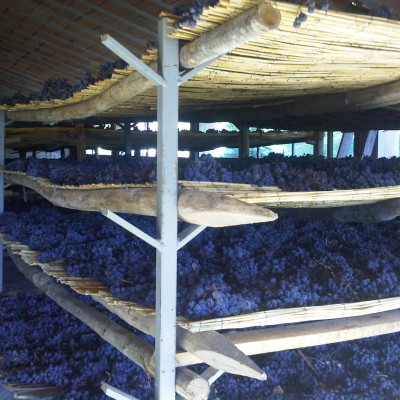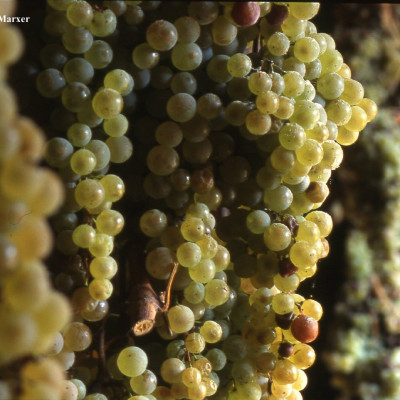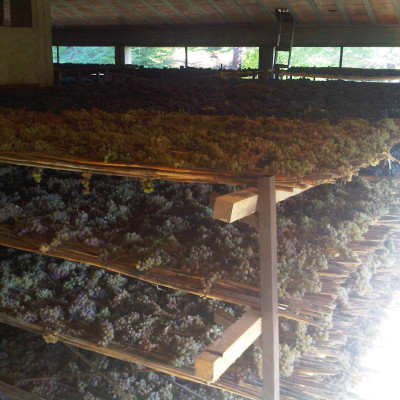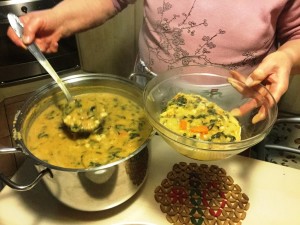Articolo disponibile anche in: Italian
The Chianti Classico hills offer “ideal contexts for the production of Vin Santo, an oxidative dried grape wine that is nourished throughout its evolution process by the microclimate of the attic space, for drying the grapes and above all in the vital fermentation and maturation stages in small oak caratelli”.
So writes Massimo Zanichelli in the preface to the Vin Santo Chianti Classico chapter of his Grande Libro dei Vini Dolci d’Italia.
Vin Santo del Chianti Classico, like all the products of the Gallo Nero area, is unique, because its organoleptic features are shaped by the exclusive and incomparable places and microclimates in its area of origin.
It is a symbol of hospitality par excellence, the wine that has always toasted special occasions in Chianti. Vin Santo del Chianti Classico is perhaps the truest expression of traditional Chianti winemaking, with its generous baggage of stories, rituals and charm.
The spectacular sight of grapes laid out in the special drying rooms, the small oak barrels that accompany the wine along its ageing process, the aromas and hues that glow in the glass after years of expectation, all speak of a truly unique and special product.
These snapshots describe a precious nectar whose memory has faded over time in a sort of limbo between legend and reality. Starting with the origin of its name.
While the first official record of Vin Santo can definitely be dated back to 1773, in the Villafranchi treaty of Tuscan Winemaking, there are various etymological explanations surrounding the origins of the name ‘Vin Santo’: from the vinification period which was, according to some, at the beginning of November, on All Saints Day, and according to others much later, in Holy Week (when, as some sources claim, the wine should be bottled).
Then, of course, there are the links to the clergy, because the wine was used during Mass. Another surviving legend claims that a Sienese monk who performed healing miracles during the plague of 1348 gave the afflicted this special wine to drink.
But the quirkiest version attributes the name to a linguistic misunderstanding in 1439 during the Council of Florence, when the word “Xantos” (“yellow” in Greek) pronounced by Bessarion (a patriarch of the Eastern Church) became “Santo” to Florentine ears, denoting the dried grape wine known at that time (and later) as “vin pretto” (pure wine).
It’s hard to say where the truth actually lies. What is certain is that – contrary to what one might think, seduced by the rural charm this wine evokes – its diffusion is due to the vices of rich noblemen who drank it as far back as the Middle Ages, because it was an exclusive product requiring an extremely laborious production process. This complex identity also characterises Vin Santo del Chianti Classico: noble in origin but the object of increasing popular approval.
Vin Santo del Chianti Classico is still a niche product awaiting discovery. It is produced in very limited quantities: less than 100,000 litres per year. This may be due to the problems and risks of such laborious production requirements, as well as the marketing difficulties that surround all great wines with evolved aromas. But it could also be interpreted as a certain attitude of closure to outsiders, a prickliness typical of Chianti that strives to protect something felt to be strictly local, familiar even, from contamination.
The production specifications for “Vin Santo del Chianti Classico” DOC, implemented in 1995, bind Vin Santo to very strict quality standards, which had to some extent become even more selective in recent years.
The production regulations include the predominant use of Trebbiano and Malvasia grapes (minimum 60%) among the approved varieties (but the Occhio di Pernice – partridge eye – type also exists, so-called for its dark, intense colour, which is made with a minimum of 80% Sangiovese); low grape yields in the vineyards and very low grape-wine yields; time restrictions for vinification and sales (no earlier than three years from the grape harvest year), but also capacity limits for the ageing casks locally called caratelli (maximum 3hl, and must be oak).
However these rules are not the whole story: in factual terms the product expresses outstanding personality, which varies from estate to estate and from year to year. We can take as read that it will be served with the dish of Sienese cakes, main Florentine sweets or the usual Prato cantuccini biscuits, but some Vin Santo del Chianti Classico can be served with certain mature Pecorino cheeses that would put the most full-bodied local red wines through their paces; sipped at a lower temperatures as an aperitif; others might be served as sipping wines at other times of day. So this highly versatile product still has plenty to reveal.
“It symbolises civility and hospitality, created according to the laws of nature and not those of men,” remarks journalist Filippo Bartolotta “An array of colours, a kaleidoscope of aromas and an ocean of flavours, ranging from dry to sweet according to the vintage, the vines and the style of each estate. The strict rules of Vin Santo DOC del Chianti Classico necessarily produce only wines of the very highest quality which deserve a more prominent position among the great sweet wines of the world”.





